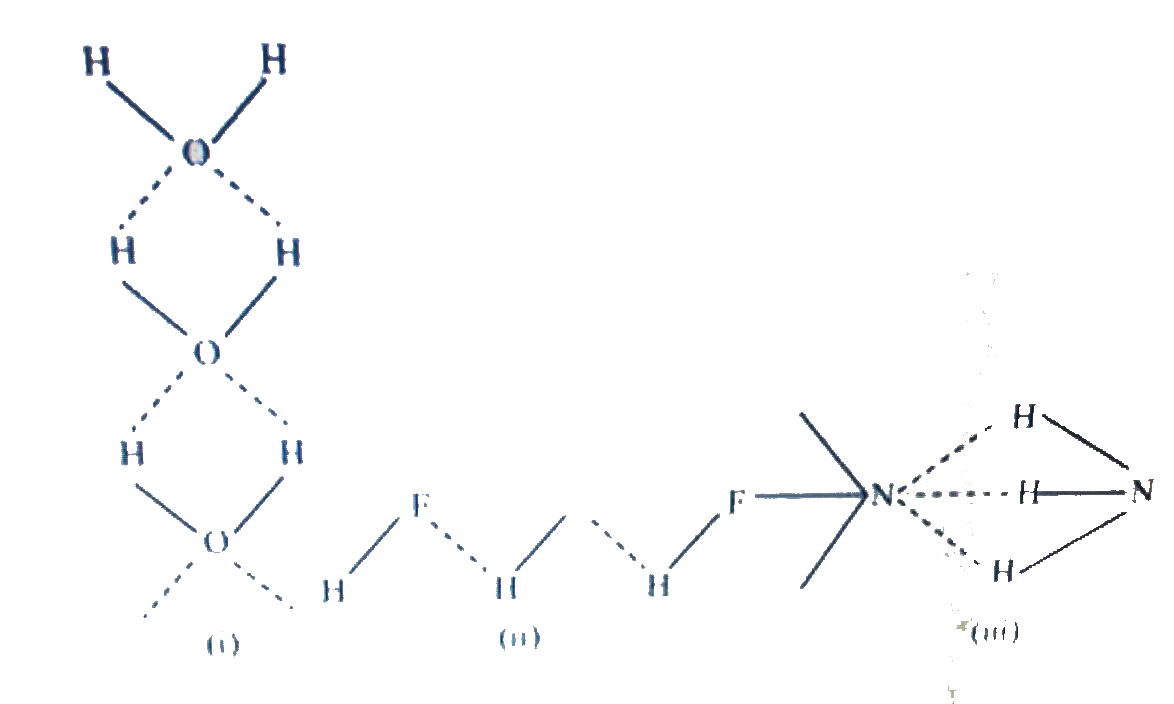Among NH3,H2O, and HF, which would you expect to have highest magnitude of hydrogen bonding and why?
The extent of hydrogen bonding depends upon electronegativity and the number of hydrogen atoms available for bonding. Among nitrogen, fluorine, and oxygen, the increasing order of their electronegativities are N<O<F.
Hence, the expected order of the extent of hydrogen bonding is HF>H2O>NH3. But, the actual order is H2O>HF>NH3.
Although fluorine is more electronegative than oxygen, the extent of hydrogen bonding is higher in water. There is a shortage of hydrogens in HF, whereas there are exactly the right numbers of hydrogens in water. As a result, only straight chain bonding takes place. On the other hand, oxygen forms a huge ring-like structure through its high ability of hydrogen bonding.
In case of ammonia, the extent of hydrogen bonding is limited because nitrogen has only one lone pair. Therefore, it cannot satisfy all hydrogens.

Topper's Solved these Questions
- HYDROGENBOOK - NCERT ENGLISHCHAPTER - HYDROGENEXERCISE - EXERCISE
36 Videos
- HYDROCARBONSBOOK - NCERT ENGLISHCHAPTER - HYDROCARBONSEXERCISE - EXERCISE
25 Videos
- ORGANIC CHEMISTRY- SOME BASIC PRINCIPLES AND TECHNIQUESBOOK - NCERT ENGLISHCHAPTER - ORGANIC CHEMISTRY- SOME BASIC PRINCIPLES AND TECHNIQUESEXERCISE - EXERCISE
40 Videos
Similar Questions
Knowledge Check
Hydrogen bonds are formed in many compounds e.g. H2O, HF, NH3. The boiling point of such compounds depends to a extent on the strength of hydrogen bond and the number of hydrogen bonds. The correct decreasing order of the boiling points above compounds is
AHF>H2O>NH3BH2O>HF>NH3CNH3>HF>H2ODNH3>H2O>HFHydrogen bonds are formed in many compounds e.g. H2O, HF, NH3. The boiling point of such compounds depends to a extent on the strength of hydrogen bond and the number of hydrogen bonds. The correct decreasing order of the boiling points above compounds is
AHF>H2O>NH3BH2O>HF>NH3CNH3>HF>H2ODNH3>H2O>HFHydrogen bonds are formed in many compounds e.g. H2O, HF, NH3. The boiling point of such compounds depends to a extent on the strength of hydrogen bond and the number of hydrogen bonds. The correct decreasing order of the boiling points above compounds is
AHF>H2O>NH3BH2O>HF>NH3CNH3>HF>H2ODNH3>H2O>HF
Which element in each of the following pairs would you expect to have higher first ionisation energy and why?
N, O
View SolutionWhich element in each of the following pairs would you expect to have higher first ionisation energy and why?
H ,He
View SolutionWhich among the following is expected to have the highest boiling point?
View SolutionHydrogen bonds are formed in many compounds e.g. H2O, HF, NH3. The boiling point of such compounds depends to a extent on the strength of hydrogen bond and the number of hydrogen bonds. The correct decreasing order of the boiling points above compounds is
View SolutionHydrogen bonds are formed in many compounds e.g. H2O, HF, NH3. The boiling point of such compounds depends to a extent on the strength of hydrogen bond and the number of hydrogen bonds. The correct decreasing order of the boiling points above compounds is
View Solution
